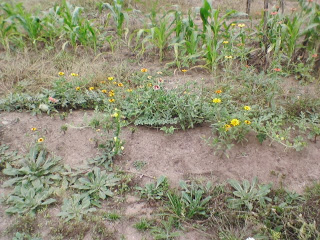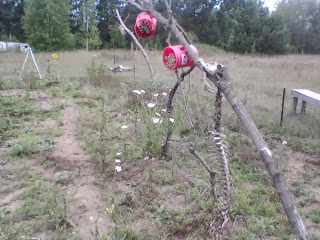This wonderful extension of the growing season has been quite a miracle! It is October 8 and we have yet to experience a hard frost! I like to think the cold is waiting on my Glass Gem corn to mature. It has silked but so far I don't think there are any mature ears yet.
This has been a really tough year for Magic Summer Minifarm, which is why I haven't been posting flower or produce availability. There is barely enough for me and the bees! I have heard that other growers in the area had a rough year also, with stunted, yellow crops. Some folks even tilled in their gardens in July when they realized they weren't going to produce much. I can't attest for anyone else but for me there have been several factors contributing to the poor production at Magic Summer.
First, the summer was slow to warm up, and then it was very warm and very dry for long stretches. I am growing in very sandy soil that doesn't hold much water.
Second, the garden was overrun with animals. The rabbits have been nuisances, but less so since my mom helped me put up a little rabbit fence around the garden perimeter. The doe who lives in the woods behind the property had triplets this year, and the four of them kept the peas about two inches tall for the first half of the growing season. More recently they have eaten the majority of the sunflowers and beans.
But the main issue is that I have pushed the sugar sand soil too far while waiting for my compost to be ready. This is the third year I have asked for produce without giving much back to build the soil. The compost is ready now, though, and I plan to spread it this fall once the hard frost does hit. I have also been building the soil with cover crops and mycelial inoculations from Fungi Perfecti. I will be spraying 500 (biodynamic horn manure preparation) and barrel compost (another biodynamic preparation--this one is made from cow manure, egg shells, and basalt) later this week, and I will use the straw from my straw bales to mulch the garden and help keep down the weeds next year. The recent rains have really brought out the mushrooms in the field, the garden, and the compost. It is sort of jarring to see them in the soil I normally think of as much dryer than I would like it to be, but in a good way. It makes me hopeful that maybe what I am doing actually is making a difference and healing the land. That was definitely not apparent two months ago.
The produce that I have been able to harvest this year includes several varieties of hot peppers (none of the peppers I grew from seed survived to produce--those that did produce were given to me by some friends), a few ears of Lindsay Meyer blue corn, American Tonda pumpkins, Iran squash, Bountiful beans (which are beautiful as well as bountiful--a great decorative and highly productive dry purple bean), shogoin white turnips, Spanish black radishes, Spacemaster bush cucumbers, and some volunteer zucchini from last year's compost pile. Oh yes, and there was also a delicious bounty of strawberries and raspberries. And a few peas. I tried growing the purple podded peas but they didn't hold a candle to the sugar snaps I planted last year that were both extremely prolific but also wonderfully sweet and tender. The purple podded peas are pretty but the pods are too tough to eat and they didn't do so well in the hostile conditions of the garden. They are recommended as a "soup pea" rather than a fresh eating pea.
Here is one of the few sunflowers that didn't get eaten by deer. Bumblebees love sunflowers!
At the top of this photo is the Glass Gem corn. In the middle you see a row that contains watermelons, okra, and zinnias. At the bottom there are lots of weeds. I hardly weeded at all this year. Part of the reason for that was I was burned out and a little lazy, but another part was allowing useful weeds like evening primrose to flourish.
Man, this photo is just depressing. even the weeds are struggling to survive. Those stick-looking things are last year's sunflower stalks. I never cut them down or pulled them out.
Here is a squash vine creeping into the strawberry patch, which is spattered with more evening primrose.
These gorgeous flowers are Persian Carpet zinnias. They are surrounded by moon and stars watermelon vines that did not produce any fruit.
So something ate almost all of the Kabuli black garbanzo beans. I was so excited about those things. I planted some more in July or August but I think they need to be planted in the spring to have enough time to mature. I will be planting fava beans this fall though. And some garlic that my late grandmother grew, thanks to my great aunt!
Lindsay Meyer blue corn with asparagus in the background. The purple flower spike is from vetch, which I planted as a cover crop in the spring.
Here is another shot of the zinnias and watermelon vines, with the scrappy nest of weeds in the walkways.
This has been a really tough year for Magic Summer Minifarm, which is why I haven't been posting flower or produce availability. There is barely enough for me and the bees! I have heard that other growers in the area had a rough year also, with stunted, yellow crops. Some folks even tilled in their gardens in July when they realized they weren't going to produce much. I can't attest for anyone else but for me there have been several factors contributing to the poor production at Magic Summer.
First, the summer was slow to warm up, and then it was very warm and very dry for long stretches. I am growing in very sandy soil that doesn't hold much water.
Second, the garden was overrun with animals. The rabbits have been nuisances, but less so since my mom helped me put up a little rabbit fence around the garden perimeter. The doe who lives in the woods behind the property had triplets this year, and the four of them kept the peas about two inches tall for the first half of the growing season. More recently they have eaten the majority of the sunflowers and beans.
But the main issue is that I have pushed the sugar sand soil too far while waiting for my compost to be ready. This is the third year I have asked for produce without giving much back to build the soil. The compost is ready now, though, and I plan to spread it this fall once the hard frost does hit. I have also been building the soil with cover crops and mycelial inoculations from Fungi Perfecti. I will be spraying 500 (biodynamic horn manure preparation) and barrel compost (another biodynamic preparation--this one is made from cow manure, egg shells, and basalt) later this week, and I will use the straw from my straw bales to mulch the garden and help keep down the weeds next year. The recent rains have really brought out the mushrooms in the field, the garden, and the compost. It is sort of jarring to see them in the soil I normally think of as much dryer than I would like it to be, but in a good way. It makes me hopeful that maybe what I am doing actually is making a difference and healing the land. That was definitely not apparent two months ago.
The produce that I have been able to harvest this year includes several varieties of hot peppers (none of the peppers I grew from seed survived to produce--those that did produce were given to me by some friends), a few ears of Lindsay Meyer blue corn, American Tonda pumpkins, Iran squash, Bountiful beans (which are beautiful as well as bountiful--a great decorative and highly productive dry purple bean), shogoin white turnips, Spanish black radishes, Spacemaster bush cucumbers, and some volunteer zucchini from last year's compost pile. Oh yes, and there was also a delicious bounty of strawberries and raspberries. And a few peas. I tried growing the purple podded peas but they didn't hold a candle to the sugar snaps I planted last year that were both extremely prolific but also wonderfully sweet and tender. The purple podded peas are pretty but the pods are too tough to eat and they didn't do so well in the hostile conditions of the garden. They are recommended as a "soup pea" rather than a fresh eating pea.
Here is one of the few sunflowers that didn't get eaten by deer. Bumblebees love sunflowers!
At the top of this photo is the Glass Gem corn. In the middle you see a row that contains watermelons, okra, and zinnias. At the bottom there are lots of weeds. I hardly weeded at all this year. Part of the reason for that was I was burned out and a little lazy, but another part was allowing useful weeds like evening primrose to flourish.
Man, this photo is just depressing. even the weeds are struggling to survive. Those stick-looking things are last year's sunflower stalks. I never cut them down or pulled them out.
Here is a squash vine creeping into the strawberry patch, which is spattered with more evening primrose.
These gorgeous flowers are Persian Carpet zinnias. They are surrounded by moon and stars watermelon vines that did not produce any fruit.
So something ate almost all of the Kabuli black garbanzo beans. I was so excited about those things. I planted some more in July or August but I think they need to be planted in the spring to have enough time to mature. I will be planting fava beans this fall though. And some garlic that my late grandmother grew, thanks to my great aunt!
Lindsay Meyer blue corn with asparagus in the background. The purple flower spike is from vetch, which I planted as a cover crop in the spring.
Here is another shot of the zinnias and watermelon vines, with the scrappy nest of weeds in the walkways.































